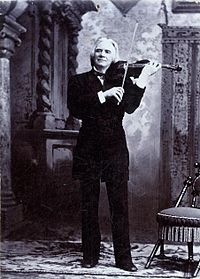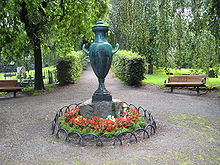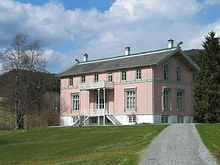- Ole Bull
-
"Ole Bornemann Bull" redirects here. For the ophthalmologist, see Ole Bornemann Bull (physician).
Ole Bull 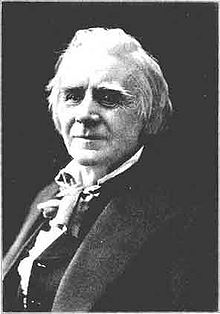
Background information Birth name Ole Bornemann Bull Born 5 February 1810 Origin Bergen, Norway Died 17 August 1880 (aged 70) Genres Classical Occupations Musician Instruments Violin Ole Bornemann Bull (5 February 1810 – 17 August 1880) was a Norwegian violinist and composer.[1][2]
Contents
Biography
Background
Bull was born in Bergen. He was the eldest of ten children of Johan Storm Bull (1787–1838) and Anna Dorothea Borse Geelmuyden (1789–1875). His brother, Georg Andreas Bull became a noted Norwegian architect. He was also the uncle of Edvard Hagerup Bull, Norwegian judge and politician.
His father wished for him to become a minister, but he desired a musical career. At the age of four or five, he could play all of the songs he had heard his mother play on the violin. At age nine, he played first violin in the orchestra of Bergen's theatre and was a soloist with the Bergen Philharmonic Orchestra.[3] At eighteen, he was sent to the University of Christiania, but failed his examinations. He joined the Musical Lyceum, a musical society, and after its director Waldemar Thane took ill, Bull became the director of Musical Lyceum and the Theater Orchestra in 1828.[4] He also became friends with Henrik Wergeland, who later wrote a biography of Bull.[4]
Career
After living for a while in Germany, where he pretended to study law, he went to Paris but fared badly for a year or two. In 1832 in Paris he shared rooms with the Moravian violin virtuoso Heinrich Wilhelm Ernst, who introduced Bull to the style of Paganini. He was eventually successful in becoming a high-level virtuoso, giving thousands of concerts. In England alone these included 274 in 1837,[4] during which visit he also travelled to some of the more remote parts of Britain.[citation needed] Bull became very famous and made a huge fortune. He is believed to have composed more than 70 works, but only about 10 are known today. Best known is Sæterjentens søndag (The dairymaid's Sunday). He also was a clever luthier, after studies in Paris with Vuillaume. He collected many beautiful violins and violas of Amati, Gasparo da Salò, Guarneri, Stradivari and others. He was the owner of one of the finest violins of the world, made by Gasparo da Salò about 1574 for Ferdinand II, Archduke of Austria. He played a Guarneri del Gesù. The violin, a gift of his widow to Bull's birthplace, is now in the Bergen Vestlandske Kustindustrimuseum.[5] A commercial signature line of Ole Bull violins was manufactured in Germany.
Bull was caught up in the rising tide of Norwegian romantic nationalism and acclaimed the idea of Norway as a sovereign state, separate from Sweden, an idea which would become reality in 1905. In 1850, he co-founded the first theater in which the actors spoke the Norwegian language, rather than Danish, namely Det Norske Theater in Bergen, which later became Den Nationale Scene.[6]
In the summer of 1858, Bull met the 15-year-old Edvard Grieg. Bull was a friend of the Grieg family, since Ole Bull's brother was married to the sister of Grieg's mother. Bull noticed Edvard's talent and persuaded his parents to send him to further develop his talents at the Leipzig Conservatory.
Robert Schumann once wrote that Bull was among "the greatest of all," and that he was on a level with Niccolò Paganini for the speed and clarity of his playing. Bull was also a friend of Franz Liszt and played with him on several occasions.
Ole Bull Colony
Bull visited the United States several times and was met with great success. In 1852, he obtained a large tract of land in Pennsylvania and founded a colony, which was called New Norway but which is commonly referred to as Ole Bull Colony. On 24 May 1852, he formally purchased 11,144 acres (45 km2) for $10,388. The land consisted of four communities: New Bergen, now known as Carter Camp; Oleana, named after him and his mother, six miles (10 km) south of New Bergen; New Norway, one mile south of New Bergen; and Valhalla.[7]
Bull called the highest point in Valhalla, Nordjenskald, which became the location of his unfinished castle. This venture was soon given up, as there was scarcely any land to till, and Bull went back to giving concerts.[8]
Family life
In 1836 Bull married Alexandrine Félicie Villeminot. They had six children, only two of whom survived him. Alexandrine died in 1862. Their children were:
- Ole Storm Felix Bull (1837-9)
- Alexander Ole Felix Etienne Bull (1839–1914)
- Thorvald Bull (1841–1862)
- Eleonore Felicie Bull (1843–1923)
- Ernst Bornemann Bull (1844; lived only 5 days)
- Lucie Edvardine Bull (1846–1868)
In 1868 Bull met Sara Chapman Thorp (1850–1911), the daughter of a prosperous lumber merchant, after a concert in Madison, Wisconsin. On a return visit in 1870 (and despite their age difference; he was 60, she was 20), Bull began a courtship, and the couple was secretly married in Norway in June 1870, with a formal wedding in Madison later that year. They had one daughter, Olea (1871–1913).
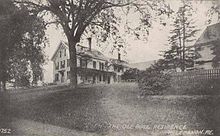 Ironwell, his summer residence at West Lebanon, Maine purchased in 1871
Ironwell, his summer residence at West Lebanon, Maine purchased in 1871
In 1871, he bought a summer home on a rise in West Lebanon, Maine. Extolling the purity and health benefits of its well water, he named the property Ironwell.[9]
Sara traveled with Bull for the remainder of his career, sometimes accompanying him on the piano. After Bull's death, the family lived in Cambridge, Massachusetts, where Sara became a figure in local intellectual life. She translated two of the works of Jonas Lie into English. In 1883 she published a memoir of Bull's life.[10] In her later life she became interested in Indian religious thought and helped sponsor early visits to the United States by gurus.[11]
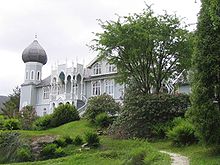 Ole Bull villa at Lysøen
Ole Bull villa at Lysøen
Later years
Ole Bull bought the island of Lysøen in Os, south of Bergen, in 1872. He hired architect Conrad Fredrik von der Lippe to design a residence on the island. Bull died from cancer in his home on Lysøen on 17 August 1880. He had held his last concert in Chicago the same year, despite his illness. A testament to his fame was his funeral procession, perhaps the most spectacular in Norway's history. The ship transporting his body was guided by 15 steamers and a large number of smaller vessels.
Legacy
- Ole Bull's villa on the island of Lysøen was donated to the Association of Norwegian Ancient Monuments Conservation. Museet Lysøen consists of violinist Ole Bull's Villa, an old farm from the 17th century.[12]
- Oleona, in Potter County, Pennsylvania, is situated in the mountains of northern Pennsylvania at the intersection of Pennsylvania routes 44 and 144 (Ole Bull Road).[13]
- Ole Bull State Park in the Susquehannock State Forest is on the original site chosen for Bull's colony. The unfinished Ole Bull Castle is maintained by the park and can be visited by hikers. A monument to honor Ole Bull was placed in the park on the 150th anniversary of New Norway in 2002.
- Mammoth Cave in Kentucky has a room called Ole Bull's Concert Hall where he once gave performances.
- Loring Park in Minneapolis, Minnesota is the site of a bronze statue memorializing Ole Bull.
- Ole Bull Cottage, originally purchased to be a school for music by Ole Bull and his wife, is at Green Acre Baha'i School in Eliot, Maine. Erected in 1896, the Ole Bull Cottage currently serves as the school library building.[14]
- Ole Bull Academy (Ole Bull Akademiet) in Voss, Norway is a music education institution founded in 1977.[15]
- Ole Bull Scene is a stage for cabaret, music and theater at the Ole Bull Plass in Bergen, Norway.[16]
- Ole Bull - Gasparo da Salò violin, a wonderful decorated masterpiece of the famous italian maker that the virtuoso used for 40 years of world tournee. Now is in the Vestlandske Kustindustrimuseum in Bergen.
- In 2006, director Aslak Aarhus released a motion picture titled Ole Bull—The Titan, the story of Bull's exploits and the impact it had on his French wife and children, who remained neglected in Bergen.
- In 2010 the Norwegian record label 2L released world premiere recordings of Ole Bull's violin concertos and his Spanish fantasy La Verbena de San Juan and a previously unknown version for violin and strings of A Sæterbesøg. The performers on the disc are Annar Follesø, violin, and the Norwegian Radio Orchestra conducted by Ole Kristian Ruud.
Media
References
- ^ Ole Bull (Store norske leksikon)
- ^ Ole Bull / utdypning (Store norske leksikon)
- ^ Ole Bull (Classical Composers Database)
- ^ a b c Haugen, Einar; Cai, Camilla (1993), Ole Bull: Norway's romantic musician and cosmopolitan patriot, University of Wisconsin Press, ISBN 9780299132507, http://books.google.com/books?id=0V_YprwSWLUC&pg=PR27
- ^ Oles magiske fiolin (Bergen Vestlandske Kustindustrimuseum)
- ^ Brekke, Nils Georg, ed (1993) (in Norwegian). Kulturhistorisk vegbok Hordaland. Bergen: Hordaland Fylkeskommune. p. 240. ISBN 82-7326-026-7.
- ^ The Ole Bull Colony in Potter County, 1852 (Potter County Historical Society, 1952; Ole Bull State Park signage, 2010)
- ^ Biography of Ole Bull(Pennsylvania Historical & Museum Commission)
- ^ "Folio, A Journal of Music, Art and Literature," edited by Dexter Smith; Boston, April 1871
- ^ Ole Bull: a memoir, 1883
- ^ Bull Curtis Papers 1830-1910 (Cambridge Historical Society)
- ^ Museet Lysøen (Kunstmuseene i Bergen)
- ^ Remembering Ole Bull’s dream (Royal Norwegian Embassy in Washington)
- ^ Ole Bull Cottage (An Intro to the History of the Green Acre Baha'i School in Eliot, Maine)
- ^ Ole Bull Akademiet (Store norske leksikon)
- ^ Ole Bull Scene
Further reading
- Bull, Sara C. (1883) Ole Bull: a memoir by Sara C. Bull; with Ole Bull's "Violin notes," and Dr. A. B. Crosby's Anatomy of the violinist (Boston: Houghton Mifflin. 1886 ed. reissued by Da Capo Press, New York, 1981) ISBN 0306761203
- Other editions: London: T. Fisher Unwin, 1886 / Boston: Longwood Press, 1978 / Ole Bull, der Geigerkönig. Ein Künstlerleben (German version by L. Ottman. Stuttgart, 1886)
- Indahl, Trond Ole Bull’s Villa (Bodoni forlag. 2010)
- Linge, Ola Ole Bull : livshistoria, mannen, kunstnaren (1953)
- Hendriksen, Knut: Ole Bull (2000)
- Bjørnstad, Ketil: Flammeslukeren Ole Bull - en livshistorie (dokumentarroman, 2005)
External links
- Ole Bull statue
- Google Earth placemark of Lysoen
- Lysoen Museum located in Lysefjorden, outside Bergen
- Ole Bull pictures on flickr commons by Bergen Public Library
- Official Ole Bull 200 year anniversary page
- List of compositions by Ole Bull
- Free scores by Ole Bull at the International Music Score Library Project
- Ole Bull's melodie La mélancolie arranged for violin and piano by Hurstinen Score from Sibley Music Library Digital Scores Collection
- Free scores by Ole Bull in the Choral Public Domain Library (ChoralWiki)
- Family Genealogy (vestraat.net)
Categories:- Norwegian classical violinists
- Norwegian composers
- Romantic composers
- People from Bergen
- 1810 births
- 1880 deaths
Wikimedia Foundation. 2010.


